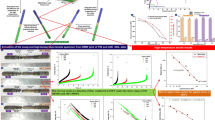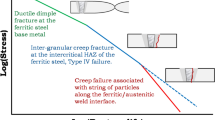Abstract
The present work investigates the high-temperature tensile and creep properties of the dissimilar metal weld joints of 304L austenitic stainless steel (SS) and P92 creep strength-enhanced ferritic-martensitic (CSEF/M) steel under different testing condition. Thermanit MTS 616 filler rod (P92 filler) and the multi-pass tungsten inert gas (TIG) welding process were used to create the dissimilar weld connection. The ultimate tensile strength (UTS) was evaluated in the temperature range of 450–850 °C. Creep testing was conducted at a temperature of 650 °C while applying stress levels of 130 MPa, 150 MPa, 180 MPa, and 200 MPa. The shortest creep life (2.53 h) was recorded for the specimen tested at 650 °C and subjected to 200 MPa, whereas the longest creep life (~ 242 h) was observed for the specimen tested at 650 °C with a stress of 130 MPa. The linear regression model was developed using an applied stress (σ) v/s rupture time (tR) plot at 650 °C. The applied stress and rupture time followed the logarithmic equation: log(tR) = 22.57566 + (-9.55294) log (σ). The detailed microstructural characterization and micro-hardness distribution across the fractured specimens was carried out. The findings demonstrated that the service life span of this weld joint at high temperature and stress conditions is influenced by the undesired microstructural changes at elevated temperature, such as coarsening of the precipitates, development of the Laves phase, softening of the matrix, and strain-ageing phenomenon.
























Similar content being viewed by others
References
Seo WG, Suh JY, Singh A et al (2021) Microstructural evolution of P92 steel in IN740H/P92 dissimilar weld joints during creep deformation. Mater Sci Eng A 821:141614. https://doi.org/10.1016/j.msea.2021.141614
Wang Q, Xin R, Wang Z et al (2022) Microstructure and its effect on high temperature tensile properties of T92/HR3C dissimilar weld joints. J Manuf Process 82:792–799. https://doi.org/10.1016/j.jmapro.2022.08.046
Zieliński A, Dobrzański J, Purzyńska H, Golański G (2016) Changes in properties and microstructure of high-chromium 9–12%Cr steels due to long-term exposure at elevated temperature. Arch Metall Mater 61:957–964. https://doi.org/10.1515/amm-2016-0163
Huang X, Shen Y, Zhu J (2015) Influence of Ar-ions irradiation on the oxidation behavior of ferritic – martensitic steel P92 in supercritical water. J Nucl Mater 457:18–28. https://doi.org/10.1016/j.jnucmat.2014.10.037
Siefert JA, David SA, Siefert JA, David SA (2014) Weldability and weld performance of candidate austenitic alloys for advanced ultrasupercritical fossil power plants Weldability and weld performance of candidate austenitic alloys for advanced ultrasupercritical fossil power plants. 1718:. https://doi.org/10.1179/1362171814Y.0000000197
Samal MK, Seidenfuss M, Roos E, Balani K (2011) Investigation of failure behavior of ferritic-austenitic type of dissimilar steel welded joints. Eng Fail Anal 18:999–1008. https://doi.org/10.1016/j.engfailanal.2010.12.011
Parker J (2016) High Temperature Performance of Creep Strength Enhanced Ferritic Steels Under Steady and Cyclic Operating Conditions. Trans Indian Inst Met 69:561–566. https://doi.org/10.1007/s12666-015-0746-y
Dak G, Singh V, Kumar A et al (2023) Microstructure and mechanical behaviour study of the dissimilar weldment of ‘IN82 buttered’ P92 steel and AISI 304L steel for ultra super critical power plants. Mater Today Commun 37:107552. https://doi.org/10.1016/j.mtcomm.2023.107552
Laha K, Chandravathi KS, Parameswaran P et al (2012) A Comparison of Creep Rupture Strength of Ferritic/Austenitic Dissimilar Weld Joints of Different Grades of Cr-Mo Ferritic Steels. Metall Mater Trans A 43:1174–1186. https://doi.org/10.1007/s11661-011-0957-8
Samuel EI, Choud BK, Palaparti DPR, Mathew MD (2013) creep deformation and rup pture behaviour of p92 steel at 92 23 K. 55:64–69. https://doi.org/10.1016/j.proeng.2013.03.220
Cao J, Gong Y, Yang Z (2011) Microstructural analysis on creep properties of dissimilar materials joints between T92 martensitic and HR3C austenitic steels. Mater Sci Eng A 528:6103–6111. https://doi.org/10.1016/j.msea.2011.04.057
Falat L, Svoboda M, Výrostková A et al (2012) Microstructure and creep characteristics of dissimilar T91/TP316H martensitic/austenitic welded joint with Ni-based weld metal. Mater Charact 72:15–23. https://doi.org/10.1016/j.matchar.2012.06.014
Matsunaga T, Hongo H, Tabuchi M (2017) Interfacial failure in dissimilar weld joint of high boron 9% chromium steel and nickel-based alloy under high-temperature creep condition. Mater Sci Eng A 695:302–308. https://doi.org/10.1016/j.msea.2017.04.012
Pandey C, Mahapatra MM, Kumar P, Saini N (2018) Some studies on P91 steel and their weldments. J Alloys Compd 743:332–364. https://doi.org/10.1016/j.jallcom.2018.01.120
Alsagabi S (2016) High Temperature Deformation Behavior of P92 Steel. Trans Indian Inst Met 69:1513–1518. https://doi.org/10.1007/s12666-015-0725-3
Peansukmanee S, Phung-on I, Poopat B et al (2022) Transmission electron microscopy of precipitation in fine-grained heat-affected zone of Grade91 steel weld during creep exposure. Micron 155:103216. https://doi.org/10.1016/j.micron.2022.103216
Khayatzadeh S, Tanner DWJ, Truman CE et al (2017) Author ’ s Accepted Manuscript. Mater Sci Eng A. https://doi.org/10.1016/j.msea.2017.10.025
Xu L, Wang Y, Jing H et al (2016) Deformation Mechanism and Microstructure Evolution of T92/S30432 Dissimilar Welded Joint During Creep. J Mater Eng Perform 25:3960–3971. https://doi.org/10.1007/s11665-016-2254-6
Shin KY, Lee JW, Han JM et al (2018) Transition of creep damage region in dissimilar welds between Inconel 740H Ni-based superalloy and P92 ferritic/martensitic steel. Mater Charact 139:144–152. https://doi.org/10.1016/j.matchar.2018.02.039
Dak G, Pandey C (2022) Microstructure anomaly during welding and its influence on the mechanical properties of dissimilar weldments of P92 martensitic steel and AISI 304L austenitic stainless steel. J Manuf Process 80:829–851
Dak G, Guguloth K, Bhattacharyya A et al (2023) Failure Study of Creep and High-Temperature Tensile Tested Tungsten Inert Gas Welded P92 Steel and AISI 304L Steel Dissimilar Weld Joints. J Mater Eng Perform. https://doi.org/10.1007/s11665-023-09070-2
Lee JH, Hwang JH, Park YS et al (2016) Assessing mechanical properties of the dissimilar metal welding between P92 steels and alloy 617 at high temperature. J Mech Sci Technol 30:4453–4457. https://doi.org/10.1007/s12206-016-0911-1
Rahman MS, Priyadarshan G, Raja KS et al (2009) Characterization of high temperature deformation behavior of INCONEL 617. Mech Mater 41:261–270. https://doi.org/10.1016/j.mechmat.2008.10.003
Sainath G, Choudhary BK, Christopher J et al (2014) Effects of temperature and strain rate on tensile stress-strain and workhardening behaviour of P92 ferritic steel. Mater Sci Technol (United Kingdom) 30:911–920. https://doi.org/10.1179/1743284713Y.0000000349
Dak G, Pandey C (2020) A critical review on dissimilar welds joint between martensitic and austenitic steel for power plant application. J Manuf Process 58:377–406. https://doi.org/10.1016/j.jmapro.2020.08.019
Song YM, Chen GH, Wang JQ et al (2014) Short-term high-temperature tensile tests and prediction of long-term strength of welded joints of dissimilar steels T92/HR3C. Met Sci Heat Treat 55:614–621. https://doi.org/10.1007/s11041-014-9678-0
Wang X, Wang X, Zhang YL et al (2021) Microstructure and creep fracture behavior in HR3C/T92 dissimilar steel welds. Mater Sci Eng A 799:140128. https://doi.org/10.1016/j.msea.2020.140128
Lei Y, Xiao C, Wang X et al (2015) Tensile properties and fracturing behavior of weld joints in the CLAM at high temperatures. Fusion Eng Des 95:27–33. https://doi.org/10.1016/j.fusengdes.2015.04.002
Ding K, Fan M, He Y, et al (2023) Microstructure evolution and its effect on the stress rupture behavior of 9%Cr-CrMoV dissimilar welded joint. Eng Fail Anal 146:. https://doi.org/10.1016/j.engfailanal.2023.107071
Kabakcı F, Acarer M, Baydoğan M et al (2021) Effect of Co Addition on the Creep Rupture Properties of 9Cr-1.8 W-x Co Weld Metals. Metall Mater Trans A 52:129–142
Guguloth K, Roy N (2017) Creep deformation behavior of 9Cr1MoVNb (ASME Grade 91) steel. Mater Sci Eng A 680:388–404. https://doi.org/10.1016/j.msea.2016.10.112
Wu G, Ding K, Wei T et al (2021) Rupture behavior and fracture mode for Inconel 625–9% Cr steel dissimilar welded joints at high temperature. Eng Fail Anal 125:105412. https://doi.org/10.1016/j.engfailanal.2021.105412
Pavan AHV, Vikrant KSN, Ravibharath R, Singh K (2015) Development and evaluation of SUS 304H — IN 617 welds for advanced ultra supercritical boiler applications. Mater Sci Eng A 642:32–41. https://doi.org/10.1016/j.msea.2015.06.065
Xue W, Qian-gang P, Yao-yao R et al (2012) Microstructure and type IV cracking behavior of HAZ in P92 steel weldment. Mater Sci Eng A 552:493–501. https://doi.org/10.1016/j.msea.2012.05.076
Swaminathan J, Guguloth K, Gunjan M et al (2008) Failure analysis and remaining life assessment of service exposed primary reformer heater tubes. Eng Fail Anal 15:311–331. https://doi.org/10.1016/j.engfailanal.2007.02.004
Gong YI, Cao J, Ji L, et al (2010) Fatigue & fracture of engineering materials & structures assessment of creep rupture properties for dissimilar steels welded joints between T92 and HR3C. 83–96. https://doi.org/10.1111/j.1460-2695.2010.01496.x
Zhou JH, Shen YF, Jia N (2021) Strengthening mechanisms of reduced activation ferritic/martensitic steels: A review. Int J Miner Metall Mater 28:335–348
Liu W, Liu X, Lu F et al (2015) Creep behavior and microstructure evaluation of welded joint in dissimilar modified 9Cr-1Mo steels. Mater Sci Eng A 644:337–346. https://doi.org/10.1016/j.msea.2015.07.068
Fedoseeva A, Dudova N, Kaibyshev R (2016) Materials science & engineering a creep strength breakdown and microstructure evolution in a 3% Co modi fi ed P92 steel. Mater Sci Eng 654:1–12
Liang Z, Zhao Q, Deng J, Wang Y (2017) Materials at High Temperatures Influence of Aging treatment on the microstructure and mechanical properties of T92 / Super 304H dissimilar metal welds. Mater High Temp 3409:1–8. https://doi.org/10.1080/09603409.2017.1334857
Li Q (2006) Precipitation of Fe2W laves phase and modeling of its direct influence on the strength of a 12Cr-2W steel. Metall Mater Trans A Phys Metall Mater Sci 37:89–97. https://doi.org/10.1007/s11661-006-0155-2
Zhang Y, Li K, Cai Z, Pan J (2019) Creep rupture properties of dissimilar metal weld between Inconel 617B and modified 9%Cr martensitic steel. Mater Sci Eng A 764:138185. https://doi.org/10.1016/j.msea.2019.138185
Sakthivel T, Sasikala G, Dash MK, Syamala Rao P (2019) Creep Deformation and Rupture Behavior of P92 Steel Weld Joint Fabricated by NG-TIG Welding Process. J Mater Eng Perform 28:4364–4378. https://doi.org/10.1007/s11665-019-04157-1
Sklenička V, Kuchařová K, Svobodová M et al (2016) Creep properties in similar weld joint of a thick-walled P92 steel pipe. Mater Charact 119:1–12. https://doi.org/10.1016/j.matchar.2016.06.033
Abson DJ, Rothwell JS (2013) Review of type IV cracking of weldments in 9–12 % Cr creep strength enhanced ferritic steels. Int Mater Rev 58:437–473. https://doi.org/10.1179/1743280412Y.0000000016
Goldenberg B (2006) A thermodynamic theory of short-term and creep rupture strength of materials. Mater Sci Eng A 419:168–171. https://doi.org/10.1016/j.msea.2005.12.022
Bai XL, Zhang Q, Chen GH, et al (2014) High temperature tensile test and creep rupture strength prediction of T92 / Super304H dissimilar steel weld joints. 31:69–76. https://doi.org/10.1179/0960340913Z.0000000009
Acknowledgements
This work was supported by the Science and Engineering Research Board (SERB-India) under the grant No: SRG/2019/001879. The authors would also like to express sincere gratitude to ‘Science and Engineering Research Board, India’ for financial support of the project entitled “Heat resistant weld joints of Inconel 617 superalloy and austenitic grade SS304H steel for Indian Advanced Ultra-Supercritical (AUSC) boiler program” under grant No: CRG/2022/007729.
Author information
Authors and Affiliations
Corresponding authors
Ethics declarations
Competing interest
The authors declare no competing interests.
Additional information
Publisher's Note
Springer Nature remains neutral with regard to jurisdictional claims in published maps and institutional affiliations.
Recommended for publication by Commission XI - Pressure Vessels, Boilers, and Pipelines
Rights and permissions
Springer Nature or its licensor (e.g. a society or other partner) holds exclusive rights to this article under a publishing agreement with the author(s) or other rightsholder(s); author self-archiving of the accepted manuscript version of this article is solely governed by the terms of such publishing agreement and applicable law.
About this article
Cite this article
Dak, G., Guguloth, K., Vidyarthy, R.S. et al. Creep rupture study of dissimilar welded joints of P92 and 304L steels. Weld World (2024). https://doi.org/10.1007/s40194-024-01757-x
Received:
Accepted:
Published:
DOI: https://doi.org/10.1007/s40194-024-01757-x




